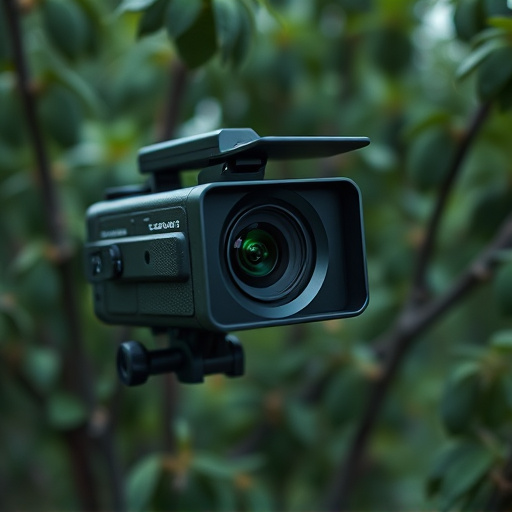Discreet battery-powered covert nanny cameras pose a significant privacy threat, but smartphone apps offer powerful tools for detection. These apps utilize visual analysis, sensor data, and machine learning to identify unusual patterns indicative of camera feeds. Advanced techniques include infrared heat signature detection. By monitoring device activity, app permissions, and conducting physical inspections with light, users can uncover hidden cameras. Upon detection, immediate action is required: power down the device, change passwords, and utilize specialized apps for enhanced security.
Uncover the secrets of hidden surveillance with our comprehensive guide on detecting battery-powered covert nanny cameras using your smartphone. Learn about cutting-edge apps and techniques, from visual cues to non-visual methods, empowering you to identify these invisible intrusions. Discover practical steps to ensure your privacy, and explore advanced prevention measures post-detection. Stay ahead of the game and reclaim control over your personal space.
- Understanding Battery-Powered Covert Cameras
- Smartphone Apps for Camera Detection
- Visual and Non-Visual Detection Techniques
- Steps to Identify Hidden Cameras Using Your Phone
- Advanced Prevention Measures After Detection
Understanding Battery-Powered Covert Cameras
Battery-powered covert cameras, often referred to as nanny cams, are a type of hidden camera designed to operate discreetly, drawing power from an internal battery rather than a traditional power outlet. These tiny devices are capable of capturing high-resolution video and still images over extended periods, making them popular for surveillance purposes. They can be easily placed in various locations, such as bedrooms, offices, or vehicles, without raising suspicion due to their unassuming appearance.
Understanding how these cameras function is crucial when it comes to detecting them. Many battery-powered covert cameras have advanced features like motion activation, night vision, and wireless data transmission. Some models even come with remote controls or mobile app capabilities, allowing users to monitor feeds from afar. Detecting such devices requires awareness of their potential hiding spots and a close inspection of any unusual activity or equipment.
Smartphone Apps for Camera Detection
Smartphone apps have emerged as powerful tools for detecting hidden cameras, particularly Battery Powered Covert Nanny Cameras, which are often used for surveillance in private spaces. These applications leverage a combination of visual analysis, sensor data, and machine learning algorithms to identify potential camera feeds. Many apps scan for unusual patterns or light signatures that could indicate the presence of a camera lens. Some advanced tools even use infrared detection, taking advantage of the heat signature left by the camera’s electronics.
The market offers various solutions, from basic security apps with camera-locating features to specialized tools designed for privacy protection. These apps often provide real-time alerts and can help users identify hidden cameras in their homes, offices, or public spaces. By utilizing smartphone technology, individuals can now proactively safeguard their privacy and security against covert surveillance.
Visual and Non-Visual Detection Techniques
Hidden cameras, often disguised as everyday objects, pose a significant privacy concern in today’s digital age. While many methods exist to detect visual elements like suspicious devices or feeds, there are equally effective non-visual techniques to uncover covert recording tools. One of the primary challenges is identifying Battery Powered Covert Nanny Cameras, which can be tiny and designed to blend into their surroundings.
Non-visual detection involves utilizing technology beyond what meets the eye. For instance, electromagnetic interference (EMI) detectors can help identify hidden cameras by picking up on unusual radio frequency signals they emit. Additionally, thermal imaging cameras can detect heat signatures that may indicate a camera’s presence, as many devices generate subtle heat even when idle. These methods are crucial in scenarios where visual inspection is not feasible or when dealing with advanced technology designed to evade traditional searches.
Steps to Identify Hidden Cameras Using Your Phone
To identify hidden cameras using your smartphone, start by examining any unusual activity or notifications on your device. Check for unexpected apps accessing your camera or microphone, as many covert nanny cameras are battery-powered and designed to operate discreetly. Look for app permissions that seem out of place or suspicious.
Next, use your phone’s lighting and angle to search for potential camera lenses. Battery-powered hidden cameras may have small, pinholes or reflective surfaces that can be detected by holding your phone in different orientations and shining light into dark spaces. Additionally, download and utilize apps designed to detect hidden cameras, as they employ advanced technologies to analyze patterns and anomalies that could indicate the presence of covert recording devices.
Advanced Prevention Measures After Detection
Once a hidden camera is detected, taking immediate action is crucial. The first step should be to power down the device and remove its battery to prevent further data transmission or recording. This is especially important for Battery Powered Covert Nanny Cameras, which can operate discreetly for extended periods.
Next, it’s vital to assess the extent of potential data breach. Check all connected devices and cloud accounts linked to the smartphone or camera itself. Change passwords immediately for any compromised accounts and review recent activities for suspicious behavior. Additionally, consider using specialized apps that can scan for hidden cameras and provide additional security measures to prevent future incidents.
In today’s digital age, being aware of hidden threats like battery-powered covert nanny cameras is essential. Smartphone apps and detection techniques empower individuals to safeguard their privacy. By understanding both visual and non-visual methods, users can proactively identify and prevent unauthorized surveillance. With the right tools and knowledge, you can navigate your surroundings with peace of mind, knowing that your personal space remains secure from these elusive devices.
